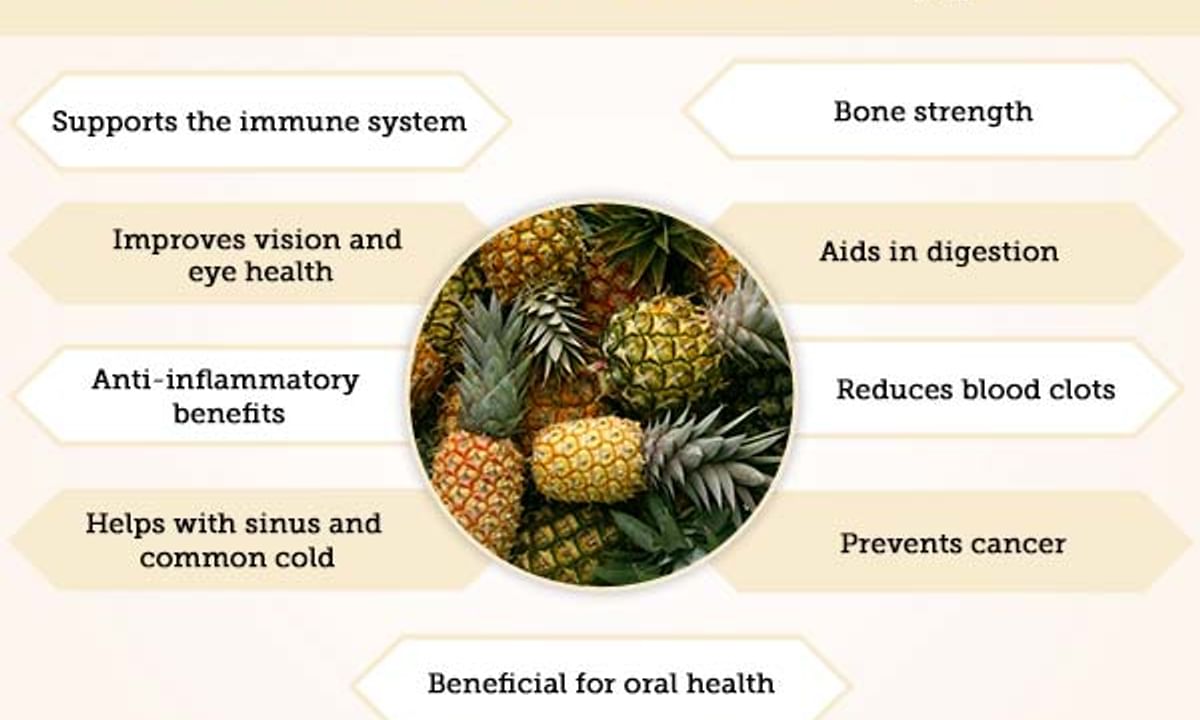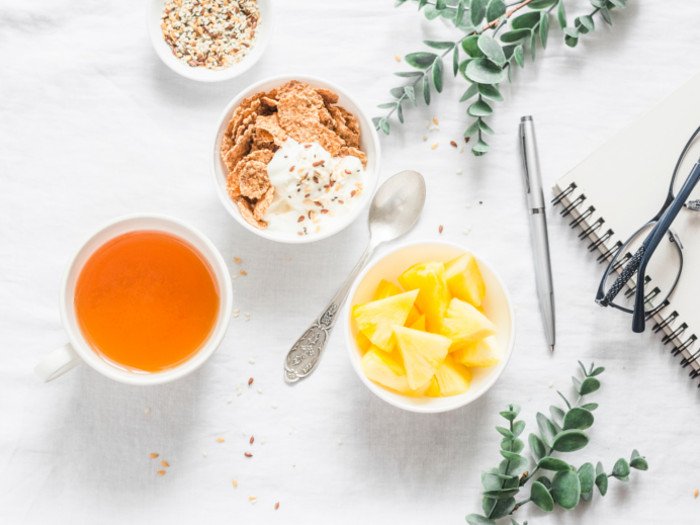As most popular Nutritionist suggests drinking “Pineapple Juice” every day. Especially, women should drink a cup of pineapple juice every morning. Read my other article “What pineapple juice does for a female body“?
So, later you want to know how much bromelain is in a cup of pineapple juice. Two slices of pineapple contain around 100mg of Bromelain. If you find it a hassle can try also pineapple liquid, tablet, or capsule dose forms.
| Pineapple Serving Size | Bromelain Content (in milligrams) |
|---|---|
| 1 cup, diced | 60-75 |
| 1 cup, crushed | 75-90 |
| 1 cup, pureed | 90-105 |
It’s worth noting that the amount of bromelain in pineapple can vary depending on a number of factors, including the type of pineapple, where it was grown, and how it was processed. Additionally, the bromelain content of pineapple is typically higher in the stem and core of the fruit compared to the flesh.
For Short Time Readers
Does Pineapple Really Lose Weight? Myth or truth?
Foods that support weight loss always deserve recognition. Some studies indicate that yes, pineapple is slimming, aiding in the reduction of body fat, although the scientific evidence of these claims tends to be equivocal, according to the US National Library of Medicine. Pineapples contain multi-core vitamins, minerals, and enzymes. However, all of these support overall health and can contribute to healthy weight loss and maintenance.
Energy Density
Foods that are low in energy density, or calories per gram, help with weight loss because they help you feel full without eating too many calories. It’s the volume of food you eat that helps you feel full, not the number of calories. Pineapple is very low in energy density, with a score of 0.5. Thus, pineapple loses weight because it is low in calories. Mixing low energy density foods like pineapple with higher energy density foods can help you lower the overall energy density of your meals. Add pineapple to low-fat yogurt or cottage cheese for a snack, on top of meat or fish with pineapple sauce for dinner, or have a fruit salad for dessert.
Bromelain
Pineapple contains an enzyme called bromelain, which helps your body digest protein. Consuming pineapple or supplemental bromelain can help people who lack digestive enzymes better digest food. This does not mean that it will destroy these foods any faster or prevent them from being stored as fatty. Bromelain does not have the power to help you process fat faster or burn it, despite claims made by fat loss pills and supplements.
Classified as a proteolytic enzyme, bromelain helps break down proteins and exists in the stem and juice of a pineapple. Historically, bromelain has been used as a digestive aid. There is not much scientific evidence that definitively links bromelain to weight loss, however, a properly functioning digestive system contributes to overall health as well as weight loss and weight maintenance.
Vitamin C
Some studies link the presence of vitamin C with increased fat metabolism. University of Arizona researchers presented a study at the 2006 Experimental Biology Symposium in which a double-blind, placebo-controlled study of 20 obese women and men showed improvements in their ability to oxidize fat after a low-fat diet. with vitamin C supplementation. Volunteers who exhibited the lowest concentrations of vitamin C had the highest body fat mass. Lead researcher Professor Carol Johnson and her team considered a possible link between vitamin C deficiency and body fat retention. Vitamin C plays an essential role in the synthesis of carnitine, an amino acid responsible for transporting fatty acids, according to Johnson. Pineapples provide rich sources of vitamin C.

Benefits
Pineapples have fiber, which some studies suggest may discourage weight gain, particularly around the abdomen. Fruits like pineapple tend to normalize blood sugar levels. This fact, in turn, shortens the appetite, which naturally promotes weight loss goals.
Snacks / snacks
Pineapples offer a healthy snack alternative. Pineapples are a good substitute for higher-calorie sweets. Especially as a late-night snack.
Prevention / Solution
Any weight loss program gains an edge when low-calorie, high-fiber, and nutrient-dense foods take precedence over high-calorie, high-fat foods. Pineapples offer a healthy alternative to sweet foods with minimal calorie intake and can contribute to weight loss if eaten alongside other low-fat foods in conjunction with exercise.
How Much Bromelain In Pineapple Juice? The Myth of Negative Calories
You may have heard that pineapples, like celery and broccoli, actually contain “negative” calories. Proponents of this belief claim that it takes more calories to digest these fiber-rich foods than they provide. This thermic effect, the energy cost of digestion, is usually much smaller and not enough to significantly affect your weight or your metabolism’s ability to burn fat.
Positive Attributes
A cup of pineapple chunks contains just 82 calories with over 2 grams of fiber. Fiber not only keeps your digestive tract running smoothly to banish bloating, but it also helps fill you up so you’re less inclined to overeat.
The Best Method
You cannot reduce fat loss. It takes dietary diligence and regular exercise. Burn excess calories through cardiovascular exercise such as running, cycling, and aerobics. Especially effective at fighting fat is high-intensity interval training, which involves alternating short bursts of all-out effort with short rests. Weight training two to four times a week also helps you build muscle; A body with a higher percentage of muscle has a higher metabolism, making it easier to lose fat. After a workout, puree some pineapple with a protein shake for a light meal that will help restore energy, help with recovery, and curb your appetite.
Pineapple peel tea: Learn what it is for and how to prepare it
Pineapple peel tea is a drink that can be consumed hot or cold. Because it is an infusion, not a juice, tea manages to preserve all the nutritional properties of the fruit. This is the best option for consumption, after fresh fruit.
According to the Ministry of Health, the pineapple peel has 38% more vitamin C than the pulp.
This high nutritional property is characteristic of the bark, seeds, leaves, and stems. However, many people still have the habit of discarding the unconventional parts of fruits and vegetables.
Here’s a tip for you to reevaluate your relationship with food. Haven’t you missed some sources of vitamins and fiber that could strengthen your health?
In today’s article, we are going to talk about the benefits of consuming pineapple peel, as well as an easy pineapple peel tea recipe, so you can enjoy the nutrients of the fruit in full.
You will learn:
- Pineapple Peel Tea: What is it for?
- Recipe: How to prepare pineapple peel tea?
- 9 benefits of pineapple peel tea
- Who can’t drink pineapple peel tea?
- Ask your questions about pineapple peel tea.
Good reading!
Pineapple Peel Tea: What is it for?
What do you usually do with pineapple peels? Are you in the habit of reusing them?
We prepared a simple pineapple peel tea recipe, which in addition to generating a tasty drink, is an excellent example of how to reuse or fully enjoy food.
The advantage of pineapple peel tea is that, in addition to reducing waste, it is a way to maintain the nutrients in the fruit.
Tea is a good alternative to consuming pineapple, taking advantage of benefits such as improving food digestion, fighting constipation, preventing diseases such as rheumatism and arthritis, as well as promoting blood cleansing.
It is also worth applying the same idea to other fruits: Orange peel has 40 times more calcium than pulp, while apple and tangerine peel have twice as much vitamin C compared to pulp.
Shall we go to the recipe?
Recipe: how to prepare pineapple peel tea?
With basic ingredients and simple step by step, it is possible to bring a delicious drink to life.
To prepare pineapple peel tea, you will need:
- 1.5 liters of water;
- Peels of a pineapple;
- 5 carnations;
- 1 cinnamon stick;
- 10 mint leaves.
Now, let’s get down to business. Or rather, in a pineapple!
First, you must put the water in a pan and put it on the fire, with the pan uncovered.
Let the water heat up before continuing with the other ingredients. When it starts to boil, add the pineapple peels.
Soon after, add the 5 cloves and the cinnamon stick. No need to stir, these ingredients will release the flavor during the infusion.
Finally, add the mint. It will complement the flavor, bringing freshness to your drink.
Now, put the lid on the pan and let it boil, with it closed, for about 5 minutes. You can check it from time to time by opening the lid. The mint should be wilted and the water will have already changed color.
When ready, remove the skins, cloves, and cinnamon. If desired, keep the mint leaves. Serve hot or cold.
Tip: Tea can be stored in the fridge for up to 3 days. Give preference to jars with a lid, to preserve the flavor and properties of the drink.
- How to consume pineapple peel tea.
- Pineapple peel is very rich in vitamins, having more vitamin C than the pulp of the fruit.
You can consume pineapple in nature, as a juice or as a tea and here, take advantage of the peel too, in addition to reducing waste, and intensifying the absorption of vitamins.
But, if you prefer the liquid version, know that it is only with tea that you can enjoy all the health benefits of pineapple. This is because the infusion preserves the nutrients of the fruit.
It can be consumed both hot and cold, it is an excellent choice for summer or winter. Also, as it can be stored for up to three days, you can make a larger amount of tea and spread out your consumption during this period.
It’s quick and easy to make, and it’s a delicious way to incorporate the benefits of pineapple peel tea into your everyday life.
Want to know more about what these benefits are? So, keep reading!

9 Benefits of Pineapple Peel Tea
Pineapple is a fruit full of benefits: it contains a lot of vitamin C, as well as bromelain, an enzyme that helps with digestion. Because of this, it helps to prevent the feeling of bloating and constipation.
Tea, being an infusion, takes better advantage of the beneficial properties of the fruit. Therefore, using the peel for pineapple tea is ideal, as it contains the highest proportion of nutrients.
Containing only 40 calories per cup, pineapple peel tea is diuretic, thermogenic, reduces appetite, and increases the feeling of satiety. Therefore, it is a great ally for those who want to lose weight.
Benefits of Pineapple Peel Tea
Do not forget, however, that to lose weight with health you need food reeducation and physical exercises. Don’t look for any miracle diets, as this type of attitude will end up destroying your metabolism. A nutritionist or a nutritionist can help you with this change of habits.
Check out the main benefits of pineapple peel tea below. Surely, at the end of the reading, you will already be putting the water to heat.
- It is a diuretic and helps in weight loss.
- It helps in the slimming process, as it has only 40 calories per cup, increases satiety, and is thermogenic (accelerating metabolism). Also, it is a diuretic, helping with the problem of fluid retention and preventing the feeling of bloating.
- Improves immunity.
- It is common knowledge that vitamin C is powerful in fighting various diseases.
Vitamin consumption strengthens immunity (no wonder this is the recommended vitamin to avoid the flu, for example). Also, remember that it is in the pineapple skin that vitamin C is most present.
- Aid indigestion.
- Vitamin C is also responsible for helping in the generation of gastric juices, which disintegrate the food consumed.
Thus, pineapple helps in digestion, as it allows a good production of digestive juice. In addition, the fruit contains an enzyme, called bromelain, which helps in breaking down protein particles.
- Improves blood circulation.
- As the vitamin C present in the pineapple peel helps to deflate, blood circulation is also beneficial, as the arteries are free for the passage of blood.
- Improves skin health and vision.
- Due to the high concentration of vitamin C, pineapple peel tea helps protect vision, even preventing cataracts.
/pineapple_annotated-24a284ff7fec4c5a9388402deacb7aa5.jpg)
In addition, to its anti-inflammatory properties, pineapple peel tea helps to improve the appearance of the skin, preventing diseases such as acne, rosacea, psoriasis, or eczema.
- Relieves arthritis symptoms.
- As already mentioned, pineapple peel tea has anti-inflammatory properties. Therefore, arthritis patients can experience relief from their symptoms by adding tea to their diet.
- Helps in cancer prevention.
- Vitamin C, present in abundance in pineapple peel, stimulates the action of white blood cells, essential for our immune system.
With its antioxidant effect, it fights free radicals, responsible for cell mutations – which cause cancer.
- Antioxidant action.
- Pineapple peel is an antioxidant, helping to prevent aging.
Want more tips on how to use food for an anti-aging treatment? Test our antioxidant juice recipe.
- Promotes bone health.
- Magnesium, which helps in strengthening bones, is present in pineapple peel. In addition, the bark has a good amount of vitamin C, which helps in the prevention of bone diseases and is anti-inflammatory.
Calcium, thiamine, and biotin are other properties present in the fruit peel that also serve to make bones stronger.
how much bromelain in 1 cup of pineapple
Bromelain is a proteolytic enzyme found in pineapple that has anti-inflammatory and digestive properties. It can be used to help treat sports injuries, reduce inflammation, and improve digestion. Bromelain is also a natural source of the amino acid tryptophan which can help promote relaxation and improve sleep quality.
Who can’t drink pineapple peel tea?
Pineapple peel tea is not suitable for people suffering from high blood pressure, pregnant or lactating women. People with stomach problems such as gastritis, ulcers, or reflux should also avoid tea consumption.
Pineapple is an acidic fruit, so it should be consumed in moderation to avoid triggering intolerances or adverse reactions such as heartburn.
Ask your questions about pineapple peel tea.
You have already understood the main benefits of consuming pineapple, and you have seen that making a pineapple peel tea takes just a few minutes of your day.
But, so that there are no doubts about the advantages of consuming this drink rich in vitamin C and anti-inflammatory and antioxidant properties, we will answer other possible questions.
Check out:
Pineapple peel tea is high in calories?
No. _ A cup of pineapple peel tea has only 40 calories. However, care must be taken with the amount consumed: despite being a drink with few calories and many benefits for the body, pineapple is an acidic fruit. Thus, excess consumption can trigger stomach problems such as reflux, heartburn, and gastritis.
Can I sweeten the pineapple peel tea?
If you are looking to enjoy the benefits of pineapple peel for weight loss, sweetening it is not a good idea.
The cinnamon and cloves, which you add to the recipe, already help to break the fruit’s acidity a little. But if you still find the drink too sour, try to use natural sweeteners such as stevia or xylitol.
Avoid, at all costs, the use of sugar. Otherwise, the positive properties of pineapple peel tea will not have much influence on your health – sugar, especially refined sugar, is a real villain for your body.
Want to know how to replace sugar in meals? Check out this article with 7 healthy and natural alternatives to choose from.
Conclusion
Pineapple is a fruit that, in addition to being delicious, has many healthy properties for our bodies.
It can be consumed in nature, as juice or tea, and it offers vitamins and other nutrients that help in strengthening immunity, and fighting a number of diseases. Other than that, it still helps with weight loss and has an anti-aging effect.
Want better justification? We have one more:
Pineapple can be eaten whole! As we’ve seen in this article, the skins, which you used to throw away, have even more vitamins than the pulp. You can use them to make your tea. Infusion is the best way to absorb all its properties.







